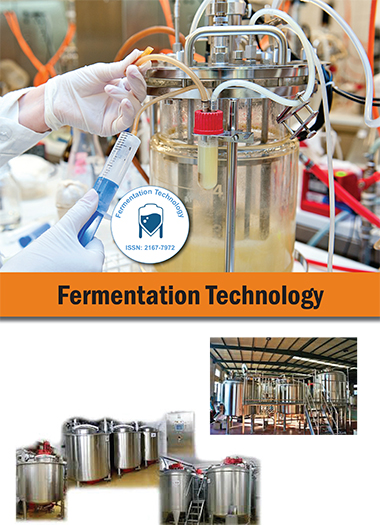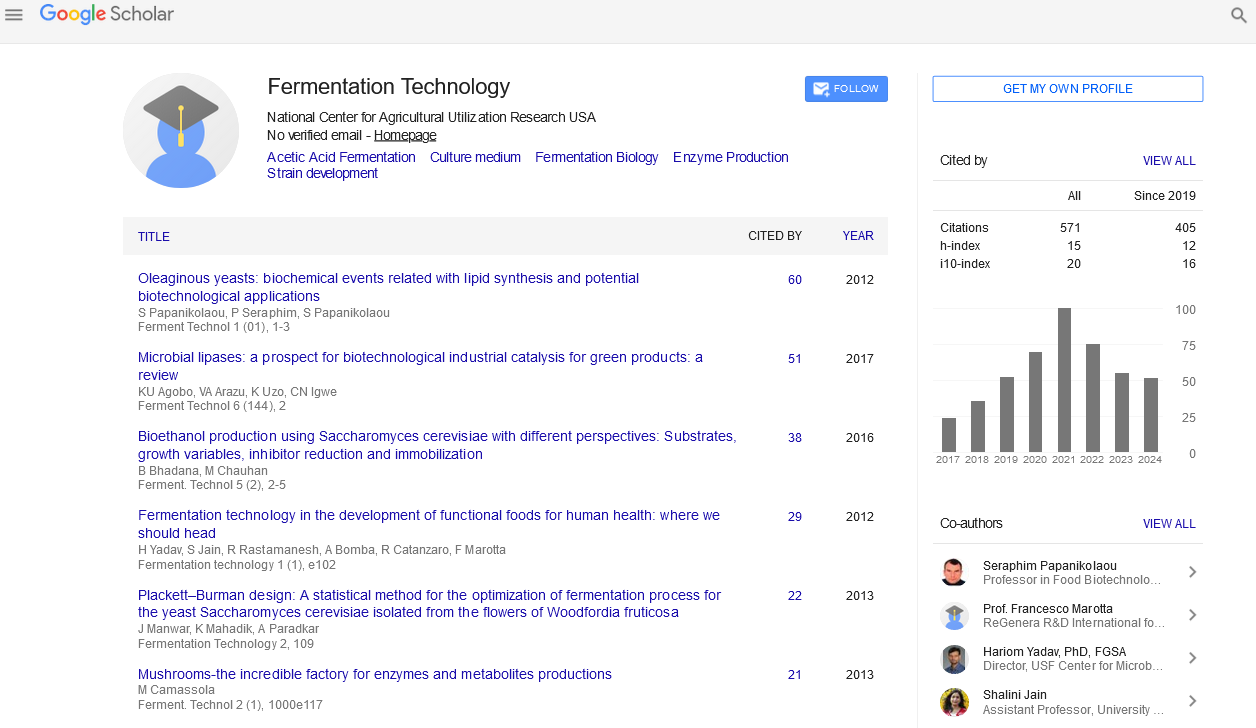Indexed In
- Open J Gate
- Genamics JournalSeek
- Access to Global Online Research in Agriculture (AGORA)
- RefSeek
- Hamdard University
- EBSCO A-Z
- OCLC- WorldCat
- Publons
Useful Links
Share This Page
Journal Flyer

Open Access Journals
- Agri and Aquaculture
- Biochemistry
- Bioinformatics & Systems Biology
- Business & Management
- Chemistry
- Clinical Sciences
- Engineering
- Food & Nutrition
- General Science
- Genetics & Molecular Biology
- Immunology & Microbiology
- Medical Sciences
- Neuroscience & Psychology
- Nursing & Health Care
- Pharmaceutical Sciences
Opinion Article - (2025) Volume 14, Issue 1
Probiotic Fermentation of Dairy and Non-Dairy Substrates: Microbial Dynamics and Functional Benefits
Michael Thomas*Received: 26-Feb-2025, Manuscript No. FMT-25-29074; Editor assigned: 28-Feb-2025, Pre QC No. FMT-25-29074 (PQ); Reviewed: 13-Mar-2025, QC No. FMT-25-29074; Revised: 20-Mar-2025, Manuscript No. FMT-25-29074 (R); Published: 27-Mar-2025, DOI: 10.35248/2167-7972.25.14.184
Description
Probiotic fermentation has gained substantial attention for its potential to deliver health-supportive compounds while enhancing the nutritional and sensory quality of foods. Traditionally associated with fermented dairy products such as yogurt and kefir, probiotics are now being incorporated into a variety of non-dairy matrices, including plant-based beverages, cereals and legumes. Understanding the microbial dynamics during fermentation is essential to optimizing probiotic viability, product safety and functional outcomes.
Probiotic microorganisms and their characteristics
Probiotics are defined as live microorganisms that confer health benefits when consumed in adequate amounts. Common probiotic genera include Lactobacillus, Bifidobacterium, Streptococcus and Saccharomyces. These organisms are selected for their ability to survive gastrointestinal conditions, adhere to the intestinal lining and exert beneficial effects such as modulation of gut microbiota, immune support and pathogen inhibition.
Viability during fermentation and storage is a key criterion for functional efficacy. Probiotic strains differ in their acid and bile tolerance, growth kinetics and compatibility with specific substrates, which makes strain selection vital for product development.
Dairy-based fermentation systems
Fermentation of milk by probiotics results in the production of organic acids, peptides, exopolysaccharides and flavor compounds. These contribute to improved digestibility, extended shelf-life and enhanced sensory attributes.
Yogurt is the most popular fermented dairy product containing probiotics, typically involving Lactobacillus delbrueckii subsp. bulgaricus and Streptococcus thermophilus in co-culture. Other fermented dairy products include kefir, cultured buttermilk and probiotic cheeses. The presence of lactose and milk proteins provides an ideal growth medium for lactic acid bacteria. However, dairy allergies, lactose intolerance and plant-based dietary preferences have driven interest in non-dairy alternatives.
Non-dairy substrate fermentation
Plant-based substrates offer an expanding platform for probiotic fermentation. These include soy milk, oat milk, almond milk, coconut water, fruit and vegetable juices and cereal flours. While these matrices are more sustainable and accessible for lactose-intolerant or vegan populations, they may lack essential growth factors such as readily fermentable sugars or specific amino acids. To address this, substrates are often fortified with nutrients or pre-treated (e.g., soaking, cooking, enzymatic hydrolysis) to enhance their suitability for fermentation.
Microbial dynamics and fermentation kinetics
Microbial growth and metabolite production vary depending on the substrate composition, pH and fermentation conditions. Lactic acid is the primary metabolic product, contributing to acidification and inhibition of spoilage organisms. Other beneficial compounds formed include bacteriocins, vitamins (e.g., B-group) and antioxidants.
Probiotic population dynamics are influenced by competition with native microbes, availability of nutrients and stress tolerance. Monitoring microbial load and metabolic activity during fermentation is critical to ensure consistency and safety. Techniques such as plate counts, qPCR and metabolite profiling are commonly employed.
Functional properties and health implications
Probiotic-fermented foods provide multiple health benefits:
Gut health: Enhance intestinal microbial balance, reduce symptoms of constipation and support nutrient absorption.
Immune modulation: Improve immune responsiveness through interactions with gut-associated lymphoid tissue.
Antimicrobial activity: Inhibit pathogens such as Salmonella, E. coli and Clostridium species via organic acid production and competitive exclusion.
Nutrient bioavailability: Fermentation reduces anti-nutritional factors (e.g., phytates, tannins) in plant matrices, improving mineral absorption.
The efficacy of probiotic foods depends on the strain used, the matrix and the viability of the microbes at the time of consumption.
Product development considerations
To ensure the stability of probiotic cultures, several factors must be considered:
Storage conditions: Refrigeration extends probiotic viability and prevents spoilage.
Packaging: Oxygen-impermeable materials and protective atmospheres help preserve live cultures.
Starter culture design: Mixed cultures may provide synergistic benefits, including improved fermentation kinetics and flavor development.
Sensory quality: Texture, taste and aroma must meet consumer expectations, especially in non-dairy products where natural flavors may differ.
Technological innovations
Encapsulation techniques such as microencapsulation or spray-drying are being used to protect probiotics during processing and storage. These technologies help maintain viability in acidic environments and improve shelf-life in ambient conditions.
Advances in strain engineering and omics technologies (genomics, proteomics, metabolomics) are also supporting the selection of more resilient and functionally active probiotic strains.
Sustainability and market trends
Non-dairy fermented products align with sustainability goals by using fewer resources and offering options for people with dietary restrictions. Consumers are increasingly seeking foods with gut-health benefits and the functional food market is responding with innovative probiotic beverages, snack bars and fermented grains.
Fermentation also supports waste reduction by allowing underutilized or surplus crops to be transformed into value-added products.
Conclusion
Probiotic fermentation offers a versatile approach to developing functional foods that support health and nutrition. While dairy remains a dominant matrix, non-dairy substrates are rapidly gaining popularity due to dietary preferences and sustainability concerns. Understanding microbial dynamics and optimizing fermentation parameters are essential to ensuring product quality and delivering beneficial effects. Continued innovations in fermentation science and product formulation will expand the scope and impact of probiotic foods across global markets.
Citation: Thomas M (2025). Probiotic Fermentation of Dairy and Non-Dairy Substrates: Microbial Dynamics and Functional Benefits. Ferment Technol. 14:184.
Copyright: © 2025 Thomas M. This is an open-access article distributed under the terms of the Creative Commons Attribution License, which permits unrestricted use, distribution and reproduction in any medium, provided the original author and source are credited.

